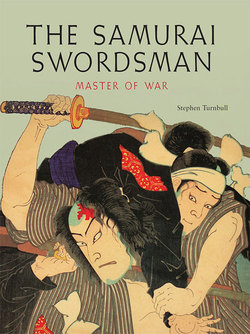Samurai Swordsman

Реклама. ООО «ЛитРес», ИНН: 7719571260.
Оглавление
Stephen Turnbull. Samurai Swordsman
Отрывок из книги
THE SAMURAI
SWORDSMAN
.....
A samurai battle would traditionally begin by the firing of signal arrows high into the air over the enemy lines. Each signal arrow had a large, bulblike, perforated wooden head that whistled as it flew through the air. The sound was a call to the kami, to draw their attention to the great deeds of bravery that were about to be performed by rival warriors. The two armies would then clash, and it is concerning this phase of a battle that the gunkimono can be most misleading. Heike Monogatari gives the impression that what followed was a series of almost exclusively individual combats between worthy opponents, who sought each other out by issuing a verbal challenge that involved reciting one’s exploits and pedigree. The challenge would be answered from within the opposing army, providing a recognized mechanism whereby only worthy opponents would meet in combat. This process, the stock in trade of the traditional samurai image, has recently been discussed critically and convincingly by Karl Friday.22 Leaving aside the obvious difficul-ties of being able to conduct verbal negotiations among the din of battle, there are in fact very few examples in the gunkimono where elaborate declarations are recorded. Instead, a more likely scenario is that samurai, when entering a battle situation, shouted out their names as war cries. Also, as Friday cleverly points out, “in any given pairing of warriors, one of the challengers would always have been a worthwhile adversary for the other,” and would be most unlikely to let the occasion pass if the other disdained his challenge! He concludes by suggesting that name calling and pedigree recitations were general, rather than specific challenges.23
The recital of pedigrees is only one aspect of samurai combat that had a ritualized form, which again has led to the misunderstanding that battles themselves were largely ritual-istic affairs: mock battles where honor could be satisfied without actually killing anyone. In fact there is only one encounter in Heike Monogatari that can be regarded as a ritualized battle, and this is the archery duel, and the series of challenges that followed it, at the Battle of Kurikara (also known as the Battle of Tonamiyama) in 1183, but on this occasion the madness had method in it. Minamoto Yoshinaka planned to divide his forces and surround the Taira army, but how was he to cover these movements and hold the Taira in position? His solution was to conceal his maneuvers by fighting a battle, but a battle so formal and so stylized that there would be no risk of his side being defeated. Nor would there be any opportunity for the Taira to realize that the whole purpose was to confine them to this small area until night fell. The trick worked, and the Taira samurai gave it their full concentration, hoping thereby to earn a name for themselves in the epic poetry that would be written about the event in the future. As Heike Monogatari relates, the Minamoto “purposely avoided a decision.”24
.....